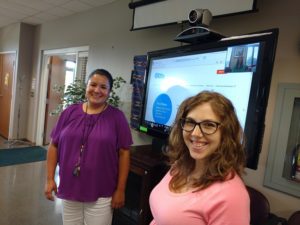Aamjiwnaang First Nation to receive access to quicker healthcare services

By Colin Graf
AAMJIWNAANG FIRST NATION—Members of Aamjiwnaang First Nation will soon have a new way to see a family doctor and to speed up wait times for seeing a medical specialist thanks to the ramping up of telemedicine services.
Within the next two months, residents will be able to visit the local health centre and consult with a doctor or other medical practitioner via video link more easily and more often.
“There will even be a clinic offered with a family M.D. two days per week,” adds Sara Plain, director of the centre.
“The video service provided by the Ontario Telemedicine Network, a non-profit group funded by the Ontario Ministry of Health, can be used for a wide variety of services,” says Joanna Hickey, provincial equity lead for the Network.
It can be used for consultations with specialists, meetings with dietitians for diabetes sufferers, discussions for new mothers with lactation consultants, and even for video visits for families with members in correctional facilities or jails.
“Anything that promotes the well-being of a person qualifies for the service,” Hickey says.
“Meeting with specialist doctors is one of the most important uses of the service at Aamjiwnaang,” says Plain. “With a number of members receiving dialysis in London, ON, an hour’s drive away, the video link can allow them to meet with their kidney specialist without making another trip.”
The service can also allow families of children at the children’s hospital in London to take part in doctor meetings if they can’t be there in person at the appointed time, notes Plain.
According to Plain, the most needed medical specialties, such as dermatology or psychiatry, can have wait times of over a year using traditional appointments in the Sarnia and London areas for Aamjiwnaang members.
Telemedicine allows patients to meet with a doctor in another part of the province who has appointments available much faster.
“If a resident has moved and wants to stay with a previous doctor, the video link can make that possible too,” continued Plain.
Community members are starting to show support for the service, and although only a few have phoned or stopped to ask in person about telemedicine, social media is showing there’s a groundswell of interest. While Facebook posts from the health centre typically get 20-40 hits, Plain’s post about the new service has over 500 views.
The Telemedicine Network first partnered with the Chiefs of Ontario in 2014, to provide medical services largely in northern Ontario communities who may not have a doctor. Today, the service is established in over 90 First Nations in Ontario and has 30 other links through friendship centres and similar locations in cities for urban Indigenous people.
The recent meeting with the Telemedicine Network representatives has helped get the health centre staff prepared to use the video equipment, to identify when a patient is suitable for the service, and how to create an appropriate clinical encounter for the patient.
The timing of the visit was perfect as Aamjiwnaang has just begun the process of setting up a video linkage for patients needing to see a family doctor through the Good Doctors Company.
“They send their own nurse for this service and run the clinic,” explained Plain.
According to Hickey, half of all users of telemedicine on Ontario First Nations are dealing with mental health or addiction issues. The service provides many different services to help with these problems, including yoga classes, AA meetings online, and visits for people away from their communities who can meet with Elders back home to discuss concerns and worries. Traditional healers can also use the link.
Telemedicine is also used every day for education and training for healthcare workers across the province.
“Helping incarcerated First Nations prisoners connect with their families or Elders from their home communities is also an important service offered,” stated Hickey. “Visiting by video link “can really help a prisoner’s state of mind.”


